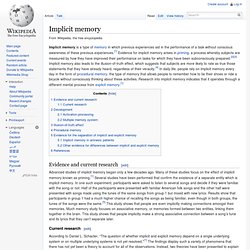

Metacognition. Neuroscience. Implicit memory. Evidence and current research[edit] Advanced studies of implicit memory began only a few decades ago.

Many of these studies focus on the effect of implicit memory known as priming.[1] Several studies have been performed that confirm the existence of a separate entity which is implicit memory. In one such experiment, participants were asked to listen to several songs and decide if they were familiar with the song or not. Half of the participants were presented with familiar American folk songs and the other half were presented with songs made using the tunes of the same songs from group 1 but mixed with new lyrics. Results show that participants in group 1 had a much higher chance of recalling the songs as being familiar, even though in both groups, the tunes of the songs were the same.[5] This study shows that people are even implicitly making connections amongst their memories. Current research[edit] According to Daniel L. There are usually two approaches to studying implicit memory. Which Way is She turning? – [IQTest] — ReadnRock.com.
Never-ending Scales - Fun Brain Teaser. Put on your headphones or turn on your speakers and listen to this sound pattern by pushing the play button(>) .

It's called a Shepard scale. You may notice that the scale always seems to be going down, but not getting much lower. It's an auditory equivalent of an old-fashioned barber pole. But how is it possible in a sound pattern? The Paradox of Shepard Scales It's not easy to describe what's going on in Shepard scales, but if you're interested keep reading! Most sounds that we think of as having a "pitch," like a singing voice or a note played on a musical instrument, are complex signals that are composed of energy at many different frequencies.
Shepard tones, like the ones you just heard, are a little different. To make things really tricky, in Shepard tones volume is set higher at a constant frequency unrelated to the "pitch" of the note (for example, 368 Hz). These features make your brain hear a seemingly impossible scale: one that constantly descends, but doesn't get any lower. Mind-Reading Computer Takes Images Straight out of Your Brain. Japanese scientists at the ATR Computational Neuroscience Labs have successfully built a machine that can read your mind - or at least getting images straight from your brain: A Japanese research team has revealed it had created a technology that could eventually display on a computer screen what people have on their minds, such as dreams.Researchers at the ATR Computational Neuroscience Laboratories succeeded in processing and displaying images directly from the human brain, they said in a study unveiled ahead of publication in the US magazine Neuron.While the team for now has managed to reproduce only simple images from the brain, they said the technology could eventually be used to figure out dreams and other secrets inside people's minds.

Link | Article at Pink Tentacle - via Gizmodo. Auditory illusion? Shortly I came across an mp3, titled the “Virtual Hair cut”, and believe me I was bewitched by the level of hearing illusion.

By the time I finished the mp3, I got hold of my hair to assure that they are ‘there’ and It was just an illusion!! So highly recommended, download and play it with the Headphones on!! (Headphones are a must). Virtual Haircut. Brain Scanner Records Dreams on Video. Just a few weeks ago, we posted about how brain patterns can reveal almost exactly what you're thinking.

Now, researchers at UC Berkeley have figured out how to extract what you're picturing inside your head, and they can play it back on video. The way this works is very similar to the mind-reading technique that we covered earlier this month. A functional MRI (fMRI) machine watches the patterns that appear in people's brains as they watch a movie, and then correlates those patterns with the image on the screen. With these data, a complex computer model was created to predict the relationships between a given brain pattern and a given image, and a huge database was created that matched 18,000,000 seconds worth of random YouTube videos to possible brain patterns. A New Book and Film About Rare Amazonian Language. In 2005 Dr.

Everett shot to international prominence with a paper claiming that he had identified some peculiar features of the Pirahã language that challenged Noam Chomsky’s influential theory, first proposed in the 1950s, that human language is governed by “universal grammar,” a genetically determined capacity that imposes the same fundamental shape on all the world’s tongues. The paper, published in the journal Current Anthropology, turned him into something of a popular hero but a professional lightning rod, embraced in the press as a giant killer who had felled the mighty Chomsky but denounced by some fellow linguists as a fraud, an attention seeker or worse, promoting dubious ideas about a powerless indigenous group while refusing to release his data to skeptics. The controversy has been simmering in journals and at conferences ever since, fed by a slow trickle of findings by researchers who have followed Dr.
Everett’s path down to the Amazon. Beau Lotto: Optical illusions show how we see. MRC CBU, Cambridge » Matt Davis.